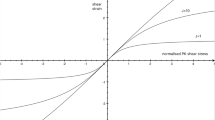Abstract
Stress intensity calculations are presented for cases of combined tensile and shear loading for a linear elastic material. Using functions of a complex variable, a theory is developed to determine the direction of maximum energy release rate. A finite element method using virtual crack extensions is also used to determine the energy release rate for crack extensions in various directions and in particular that which gives the maximum energy release rate.
Except when shear is more significant than tension, these results give good agreement with available experimental evidence. When shear is most significant, plasticity effects are probably becoming important, thereby invalidating the results of any linear theory. However, the results may still be used to determine K I and K II numerically from virtual crack extension calculations of J 1 and J 2 for general two-dimensional geometries.
Résumé
On présente des calculs de l'intensité des contraintes dans les cas de mises en charge combinée par traction et cisaillement d'un matériau redevable de la mécanique linéaire et élastique. En utilisant des fonctions d'une variable complexe, on développe une théorie pour la détermination de la direction du taux maximum de relaxation de l'énergie. Une méthode par éléments finis utilisant des extensions d'une fissure virtuelle est également employée pour déterminer le taux de relaxation de l'énergie correspondant à des extensions de la fissure dans des directions diverses et, en particulier, dans celle qui donne un taux de relaxation maximum de l'énergie.
A l'exception du cas où le cisaillement est significativement plus important que la traction, les résultats sont en bon accord avec les observations expérimentales. Lorsque le cisaillement est proportionnellement le plus significatif, les effets de la plasticité deviennent probablement importants, et rendent invalides les résultats de toute théorie élastique linéaire. Toutefois, la méthode peut être encore utilisée pour la détermination numérique de K I et K II au départ de calculs de J 1 et J 2 correspondant à une extension d'une fissure virtuelle dans des géométries bidimensionnelles.
Similar content being viewed by others
References
Pin Tong and T. H. H. Pian, On the convergence of the finite element method for problems with singularities, Int. Jnl. Solids and Struct., 9 (1973) 313–321.
J. R. Rice, A path independent integral and the approximate analysis of strain concentration by notches and cracks, Jnl. Appl. Mech., 34 (1968) 379–386.
J. R. Eshelby, The continuum theory of lattice defects, Solid State Physics, 3 (1956).
G. L. Cherepanov, Cracks in Solids, Prikl. Math. Mekh., 25 (1967) 476–488.
J. K. Knowles and E. Sternberg, On a class of conservation laws in linearised and finite elastostatics, Arch. Rat. Mech. Anal., 44 (1972) 187–211.
B. Budiansky and J. R. Rice, Conservation Laws and Energy Release Rates, Jnl. Appl. Mech., 40 (1973) 201–205.
A. E. Green and W. Zerna, Theoretical elasticity. Oxford Univ. Press. 1954.
A. A. Griffith. The phenomenon of rupture and flow in solids, Proc. 1st. Int. Congr. Appl. Mech., 1924.
F. Erdogan and G. C. Sih, On the crack extension in plates under plane loading and transverse shear, Jnl. Basic Eng., 85 (1963) 519–527.
S. Iida and A. S. Koboyashi, Crack propagation rate in 7075-T6 plates under cyclic tensile and transverse shear loadings, Jnl. Basic Eng., 91 (1969) 764–769.
V. B. Watwood, Nucl. Eng'g. Design, 11 (1969) 323–332.
J. R. Rice and D. M. Tracey, Computational Fracture Mechanics, in Numerical and Computer Methods in Struct. Mechs., Academic Press, N.Y. (1973).
K. Jerram and T. K. Hellen, Finite Element Techniques in Fracture Mechanics, Int. Conf. on Welding Research related to Power Plant, Southampton (1972).
T. K. Hellen, The Finite Element Calculation of Stress Intensity Factors using Energy Techniques, Conf. Struct. Mechs. in Reactor Tech., Berlin (1973).
T. K. Hellen, The Application of the BERSAFE Finite Element System to Nuclear Design Problems, Conf. Struct. Mechs. in Reactor Tech., Berlin (1971).
W. S. Blackburn, Calculation of Stress Intensity Factors at Crack Tips using Special Finite Elements, Conf. Mathematics of Finite Elements and Applications, Brunel University (1972).
J. G. Williams and P. D. Ewing, Fracture under complex stress the angled crack problem, Int. J. Fract. Mech., 8 (1972) 441–446.
L. P. Pook, The effect of crack angle on fracture toughness, Eng. Fract. Mechs. 3 (1971) 205–218.
K. Jerram, C.E.G.B. Report RD/B/N 1777 (1970).
P. C. Paris and F. Erdogan, Jnl. Basic Eng., 85 (1963) 528–534.
P. C. Paris and G. Sih, Fracture Toughness Testing and Its Applications, ASTM Special Technical Publication No. 381, Philadelphia (1965) 30–81.
Author information
Authors and Affiliations
Rights and permissions
About this article
Cite this article
Hellen, T.K., Blackburn, W.S. The calculation of stress intensity factors for combined tensile and shear loading. Int J Fract 11, 605–617 (1975). https://doi.org/10.1007/BF00116368
Received:
Issue Date:
DOI: https://doi.org/10.1007/BF00116368




